In this article, we’ll be taking a look at what is a virgin, an extra virgin or not a virgin oil at all.
There are many types oil available nowadays and it can be confusing, therefore, when deciding what to buy. I’ll be looking at how vegetable oils are processed and, as a result, what it says on the label.

In my recent article “Eat Well And You Will Feel Happier: Change Your Diet To Lift Your Mood“, I wrote about the various types of oil and fat. Because it is such a complex subject, I said they deserve an article of their own. In fact, they need more than one article and here is the first, about the different types of vegetable oil.
Processing method
You will often see vegetable oil labelled ‘extra virgin’, ‘virgin’, or ‘light’. I looked in my own cupboard and saw I had ‘cold pressed’ and ‘blended’ extra virgin olive oil. Here I’ll describe the main methods of processing:
Extra virgin oil
Extra virgin oil undergoes the minimum of processing. In other words, the oil is simply squeezed out. It contains a higher level of the plant’s flavour. This means the flavour of the fruit or seed will be imparted into the taste of what you are cooking. To be classed as extra virgin, the oil is produced from the first press, at a temperature not exceeding 27⁰C.

Cold pressed extra virgin oil
By definition, all extra virgin oil is cold pressed or cold extracted by mechanical means, at a temperature of no more than 27⁰C. The terms cold pressed or extracted are used for marketing purposes and to make the product sound more appealing.
Blended extra virgin oil
You might see a label saying that the oil is a blend. I have a bottle of olive oil with a label that says ‘a blend of olive oils of European Union origin’.
Extra virgin olive oil is expertly blended by the processing company to obtain a unique flavour. Blended olive oil is less likely to be affected by weather conditions or pest problems – the producer is able to select fruit or seed to maintain a consistency of quality.
Virgin oil
Oil labelled as virgin has only been mechanically treated, pressed olives or sunflower seeds, for instance. The oil will not have been chemically treated but it will have been heat treated. It doesn’t have to be from the first press of the fruit of seed; the remaining pulp from the first squeeze can be put through the mechanical process again to obtain oil.
Non virgin oil
If a label doesn’t claim that it’s virgin or extra virgin, the oil will be non virgin. The processing will have involved both heat treating and chemical treating. Non virgin oil is the oil of choice for processed food. It has no flavour of the plant and it’s cheaper.

Light
When you see ‘light’ on a label, you might think it has a lower fat content than standard oil, but this isn’t what it means at all. The oil is produced from mixing extra virgin oil with refined oil, and this makes an oil that is lighter in colour. Light oil can be used at a higher cooking temperature than virgin oils and is widely used commercially. It has a longer shelf life, is easier to store, and it is cheaper too.
Conclusion
If you want to go for purity and the least processed, then choose extra virgin oil. But you have to be prepared to taste the flavour of what the oil has been made from. Also, if you are frying food, you must consider the ‘smoke point‘, the temperature at which the oil becomes unstable and, therefore, potentially harmful to your health.

There’s the balance between omega-3 and omega-6 fatty acids to be aware of, as well. Very basically, omega-3 is good, omega-6 is bad, and refined oils will contain too much omega-6.
Bear in mind, also, the food miles, how far the oil has travelled to reach your local shop’s shelf. And the oil’s shelf life, how long it will last.
And finally, for now, consider the price. Some artisan oils are eye-wateringly expensive! Other oil will be far cheaper and this will affect what you choose.

Pingback: Coconut oil; Nutritional And Non-Nutritional Benefits of Coconut Oil
Pingback: Six Food Types to Benefit People with Sickle Cell Disease - Dinachi Food & Nutrition